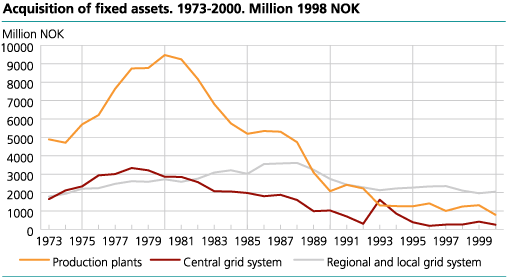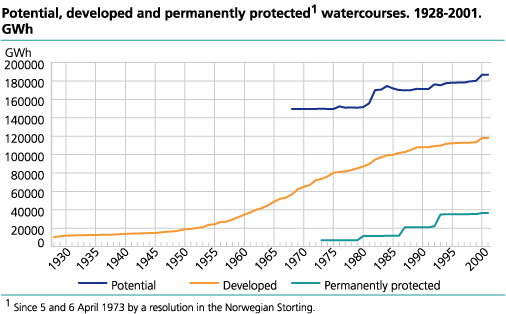Content
Published:
This is an archived release.
Low investment in power industry
The gross investment in the power industry was NOK 3.9 billion in 2000. This is down 18.7 per cent compared with 1999, and also low in a historical perspective.
The investments in production plants were NOK 834 million in 2000. This is down 37.9 per cent compared with the investments in 1999. Preliminary figures for 2001 and 2002 indicate an upward adjustment. The low investments in the expansion of the production capacity may be seen in connection with - on average - low prices of electric energy. Investments in the central grid system went down 60 per cent compared with 1999, while the regional and the local grid system increased by 7.5 per dent. The fall in investments in the central grid system is among other factors due to the postponement of planned transmission cables to the Netherlands, England and Germany.
Record high production
The production was 142,3 TWh in the water-based production of electric energy in 2000. This is 16.2 per cent more than the previous record in 1995, and 20.6 per cent more than the production in a normal year. This is close to the maximum of capable production of electric energy in the Norwegian water-based production. In comparison the production in the dry year 1996 was 105 TWh. The high production can be seen in connection with the high trickle of water this year. The production from thermal power stations was 450 GWh, and wind power contributed 31 GWh. Hydroelectric power represented 99.6 per cent of the total production of 143 TWh. The net export of 19.2 TWh is the highest ever recorded.
No change in net consumption
Net consumption was 110.9 TWh in 2000. This is up 0.4 per cent from 1999 and 1998. Norway is among the highest consumers of electric energy in the world. There are several reasons for this high consumption. Other economies have a different combination of energy use that includes oil, gas and district heating. The Norwegian energy use is slightly above the average of the OECD-economies. In production of paper and paper products the consumption increased by 15.2 per cent from 1999. Expensive oil in 2000 contributed to a substitution to more use of electric energy in this sector. Private households had a decrease of 1.3 per cent to 36.7 TWh in 2000. Warm weather in 2000 may explain this decrease in consumption. The consumption in power-intensive manufacturing rose by 0.7 per cent to 33 TWh.
Prices down
The price of electric energy decreased by 12.5 per cent to 13.3 øre/kWh in 2000. The tariff on distribution in total did not change and was 16.6 øre/kWh. With energy tax included the price in total was 34.4 øre/kWh. This is down 6.3 per cent compared with the price in 1999. The energy tax rose from 5.94 to 8.56 øre/kWh in 2000. The total price for private households rose from 40.5 øre/kwh in 1999 to 42.2 øre/kWh in 2000, VAT not included. It is mainly the increase in the energy tax that led to higher prices for private households.
Record high results
The operating results have been stable recent years, but the power sector received impetus in 2000 concerning the operating results. The operating result of NOK 11.6 billion is 10.6 per cent more than in 1999. Production plants and high-integrated plants clearly improved, while wholesale plants, distribution plants and other plants experienced a decrease in the operating results. This may indicate that the economic profit of the high precipitation in 2000 is related to the production of electric energy. The annual profit rose by 17.7 per cent to NOK 6.7 billion in 2000, of which NOK 3.7 billion are proposed dividends.
Tables:
- Table 1 Main figures. 1989-2000
- Table 2 Potential, operational and not operational hydro power, by county. 2000 and 2001. GWh
- Table 3 Water in reservoirs. 1994-2002. Per cent of total reservoir capacity
- Table 4 Capacity of installed machinery, by type. 1950, 1955 and 1960-1999
- Table 5 Capacity of installed machinery, by type, county and ownership group. 2000
- Table 6 Power stations, by size (maximum output). 1974-2000
- Table 7 Hydro-electric power stations, by size (maximum output) and county/ownership group. 2000
- Table 8 Lines at the end of the year, by type of line. 1974-2000. Km
- Table 9 Lines at the end of the year, by type of line and voltage. 2000. Km
- Table 10 Lines at the end of the year, by type of line and county1
- Table 11 Transformers at the end of the year, by county/ownership group. 2000
- Table 12 Production, imports, exports and consumption of electric energy. 1950, 1955 and 1960-2000. GWh
- Table 13 Production of electric energy, by type, county and ownership group. 1998-2000. GWh
- Table 14 Electricity balance, by year1. 1994-2002. GWh
- Table 15 Net consumption of electric energy, by consumer group. 1960 and 1965-2000. GWh
- Table 16 Net consumption of firm power in mining, quarrying and manufacturing industries, by consumer group. 1960 and 1965-2000. GWh
- Table 17 Net consumption of electric energy, by type and consumer group. 1999 and 2000. GWh
- Table 18 Net consumption of total electric energy, priority and non-priority, by consumer group and county. 1999 and 2000. GWh
- Table 19 Net consumption of total electric energy in households per capita, by county. 1993-2000. kWh
- Table 20 Weighted average prices for electricity and grid rent, exclusive of VAT. 1997-2000. øre/kWh
- Table 21 Prices of electric energy and transmission, by consumer group. 2000. øre/kWh
- Table 22 Distribution of prices of electric energy for households, by quantiles and standard deviation. 1993-2000. øre/kWh
- Table 23 Prices of electric energy and transmission to households, by county. 2000. øre/kWh
- Table 24 Prices of electric energy traded in the wholesale market and concession power. 1994-2000. øre/kWh
- Table 25 Average prices of imports and exports of electric energy. Sweden and Denmark. 1973-2001. øre/ kWh
- Table 26 Prices and traded volume in the spot market for electricity. Weekly. 1995-2002
- Table 27 Prices of electric energy exclusive of taxes. Quarter. øre/kWh
- Table 28 Prices of electric energy for households inclusive of taxes. Quarter. øre/kWh
- Table 29 Prices of electric energy traded in the wholesale market. Quarter. øre/kWh
- Table 30 Number of utilities and generators, persons engaged and staff-years, by type of utility and activity. 1999 and 2000
- Table 31 Internal accounts, by type of activity for all units in electricity supply. 1999 and 2000. Million kroner
- Table 32 Economic main figures for all units in electricity supply. 1999 and 2000. Million kroner
- Table 33 Income statement for enterprises in electricity supply, by type of utility. 1999 and 2000. Million kroner
- Table 34 Balance sheet for enterprises in electricity supply, by type of utility. 1999 and 2000. Million kroner
- Table 35 Key figures for enterprises in electricity supply, by type of utility. 1999 and 2000
- Table 36 Income statment for enterprises in electricity supply, by ownership group. 1999 and 2000. Million kroner
- Table 37 Balance sheet for enterprises in electricity supply, by ownership group. 1999 and 2000. Million kroner
- Table 38 Key figures for enterprises in electricity supply, by ownership group. 1999 and 2000
- Table 39 Acquisition and sale of fixed assets, by type of capital. 2000. Million kroner
- Table 40 Acquisition of fixed assets, by type of utility, county and ownership group. 2000. Million kroner
The statistics is published with Electricity.
Contact
-
Statistics Norway's Information Centre
E-mail: informasjon@ssb.no
tel.: (+47) 21 09 46 42


